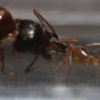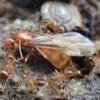- Formiculture.com
- Forums
- Gallery
- Members
- Member Map
- Chat

How to Find Certain Queens/Colonies
Started By
Nathant2131
, Dec 31 2016 5:21 PM
23 replies to this topic
#21
 Offline
-
Posted January 13 2017 - 8:36 PM
Offline
-
Posted January 13 2017 - 8:36 PM
We had Polyergus raids going across our driveway most of the summer 😁. Almost every late afternoon / early evening we'd see them. Very cool to watch.
#22
 Offline
-
Posted January 14 2017 - 4:03 PM
Offline
-
Posted January 14 2017 - 4:03 PM
I would highly recommend the book "A Field Guide to the Ants of New England" cause it was basically written for this purpose. Also most of the ants on your list are found in deciduous forests and along forest edges where you'll be finding a LOT more species. Formica is particularly diverse in your state so this book will be handy with identification. It will also help you be able to tell the ants that are on your list apart. L. flavus and L. nearticus are fairly similar-looking, not to mention all the Aphaenogaster on and off your list.
Aphaenogaster fulva: you'll find in deciduous forests nesting in rotting logs and old stumps. Violets are a good sign as they disperse the seeds to these species. They're also a primary host to A. tennesseensis which may be commonly found where they occur.
-Aphaenogaster picea: deciduous forests but more restricted to damp environments. Assorted wildflowers are a good sign, not just violets.
-Aphaenogaster rudis: same as A. fulva but more widely spread, and more likely to be found nesting in soil though often still under rocks and logs. Also more focus on other wildflowers, not just violets.
-Myrmica rubra: wet environments. Nest under rocks and logs.
-Myrmica punctiventris: Deciduous forests. Nests under bark and fallen trees.
-Myrmica americanus: Sandy soil open fields and grasslands.
-Ponera pennsylvnica: Damp forests and soggy fields. Nest anywhere there's enough moisture, under rotting logs, stumps, leaf litter, under rocks. Personally I've never found them nesting in sandy soil so you might have better luck in clay.
-Pheidole pilifera: Exposed sandy soil environments.
-Crematogaster cerasi: nest in rotting wood along forest edges and clearings.
-Crematogaster lineolata: more at home in open fields but can be found along forest edges and shrub lands. They tend aphids and other dew producing insects occasionally building little sheds around for added protection. (C. cerasi might do this too.)
-Formica subsericea: They prefer moist woodlands, nesting both in soil and dead wood. They're also common in dry sphagnum bogs and nutrient poor fens... (e.g. carnivorous plants). Speaking personally though I've found them nesting in dry spots along road sides too though there was often a ditch nearby. So water seems to be important for their food sources.
-Camponotus novaeboracensis: Nest in living trees, stumps, and logs, as well as large pieces of downed wood "or within cow dung."
-Camponotus americanus: Open habitats and forests often under stones.
-Camponotus herculeanus: not found in your county sadly. Need to head a bit west or immediately north of your current location. They nest mostly in living trees and occasionally rotting (water damaged) parts of homes.
-Lasius flavus: Dry woodlands and open habitats. Completely subterranean except for their flight season in August and September. You'll find them under rocks.
-Lasius nearcticus: Opposite of L. flavus, nest under rocks in moist forests. Completely subterranean except for their flight season around August or September. You'll find them under rocks.
- Nathant2131 likes this
North America: Ant Genera, Species List, "Native Plants for Honeybees" | My YouTube Channel
#23
 Offline
-
Posted January 28 2017 - 5:02 PM
Offline
-
Posted January 28 2017 - 5:02 PM
Also check out this book (really helpful, @batspiderfish recommended it to me.) Can get it used from Amazon or other sources to save money:
A Field Guide to the Ants of New England
The book arrived in the mail a couple days and it's incredible, thanks for the reccomendation! As for this topic, I think this book has basically resolved all of my questions.
#24
 Offline
-
Posted January 29 2017 - 8:11 AM
Offline
-
Posted January 29 2017 - 8:11 AM
MILTA I believe it's rudis which is the host
Visit us at www.canada-ant-colony.com !
1 user(s) are reading this topic
0 members, 1 guests, 0 anonymous users















